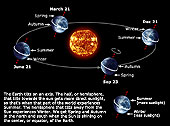
Days
& Seasons
The Earth rotates on an axis. Imagine that the Earth has a big pole
stuck through its center, from the North Pole to the South Pole. This
is the Earth's axis. Now, give the Earth a good push and it will spin
around the pole. While one side of the Earth receives sunlight, the opposite
side has night. As Earth spins, daytime slowly gives way to nighttime
and nighttime slowly brightens to give us daytime. Earth makes one
complete turn every 24 hours.
Not only does the Earth rotate on its axis, but it also orbits, or revolves
around, the Sun. A year is how long it takes a planet to orbit the
Sun. It takes the Earth approximately 365 days. During this time, Earth
experiences a change in season. Seasons change because the Earth is tilted.
As the Earth goes around the Sun, some places on Earth receive more or
less direct sunlight and have more or less hours of daylight. Also,
as the year progress, sometimes the Sun rise and set more north or south
on the horizon.
Solstice:
The first day of summer and winter are the days when the Sun shines on
Earth most directly at its lowest and highest from points the equator.
The equator is an imaginary line around the Earth that is equal distance
between the North and South Poles. There are two solstices: the summer
solstice occurs around June 21and is when the Sun is at its northernmost
point above the equator. This day marks the beginning of summer in the
northern hemisphere. The winter solstice occurs around December 21 and
is when the Sun is at its southernmost point below the equator. This day
marks the beginning of winter in the northern hemisphere. The summer solstice
is the day that has the most hours of daylight and the winter solstice
is the day that has the shortest hours of daylight of a year.
Equinox:
The first day of spring and autumn are the days when the Sun shines on
Earth most directly at the equator. This happens twice each year.
On thesedays, there are approximately 12 hours of daylight and 12 hours
of night. The vernal (spring) equinox occurs around March 21st. This day
marks the beginning of spring in the northern hemisphere. The autumnal
equinox occurs on September 23rd. This day marks the beginning of autumn,
or fall in the northern hemisphere.
«
previous 2
of 3
next
»

|

|

|

|

|
G A L L E R Y |

See how the tilt of the Earth and it's orbit around the Sun affects
the seasons. [enlarge] |
|
| M
O R E |
Learn
more about how the solar cycle is used to keep time by these cultures:
|
|
|